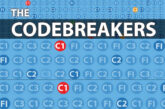
Need help with cracking those EICR codes? The technical team at NAPIT, with the help of the 18th Edition Codebreakers publication, answer your latest coding queries. Click on the photos for a closer look!
TEL JOHNSON: Pictured here is a shower installation SWA that goes through the wall to the outside and up to the attic!
Well, this is a clear case of how not to install a shower to an existing Consumer Unit (CU). To Code this, it’s best to start at the RCBO and move to the junction box in the attic.
I’m not going to pass comment on the conductor CSAs or RCBO operating current, as this is difficult to determine from the picture, and as the appliance size isn’t known.
Starting with the RCBO, we can see that it is a different manufacturer to that of the CU. Due to the mixing of different manufacturers now no longer allowed (unless the manufacturer of the CU allows this), the RCBO will fall foul of Reg 536.4.203. This will attract a C3 or a C2 if thermal damage is present. If the permission from the original manufacturer to use the RCBO is in contention, then an FI should be issued.
 Although not usually a codable issue, I feel it must be raised in this instance as it’s inside a CU with older cable colours and could be mistaken for a Neutral conductor. The black conductor of the SWA has been configured as the CPC, without any green and yellow sleeving for identification. Due to the slightly increased risk of error from the older cable colours there would be warranted reason to Code this C3.
Although not usually a codable issue, I feel it must be raised in this instance as it’s inside a CU with older cable colours and could be mistaken for a Neutral conductor. The black conductor of the SWA has been configured as the CPC, without any green and yellow sleeving for identification. Due to the slightly increased risk of error from the older cable colours there would be warranted reason to Code this C3.
Moving on to the SWA, it’s evidently not terminated correctly at either end, neither is it likely to be supported adequately to protect against mechanical stress. Add to that the armour not being connected to the CPC and we have a multitude of infringements, which to be fair will attract harsher Codes.
 Entry into the CU for the SWA is likely to be via a badly modified CU, which may or may not attract a Code, so for this exercise, I’ll assume the CU was safely and adequately modified. If it wasn’t and there are structural or IP rating issues, this would obviously attract a harsh Code.
Entry into the CU for the SWA is likely to be via a badly modified CU, which may or may not attract a Code, so for this exercise, I’ll assume the CU was safely and adequately modified. If it wasn’t and there are structural or IP rating issues, this would obviously attract a harsh Code.
Termination within the plastic enclosure is also a problem, chiefly from the badly damaged top surface and IP rating infringement.
Finally, for this monstrosity, is the cable termination within the plastic enclosure. As we can’t say what the loading is or the current carrying capacity of the connector strip, I’d have to go with an FI, to confirm these queries before giving a defined Code. That said, it’s not likely to be a good prognosis.
Get more details about NAPIT Codebreakers by clicking here









